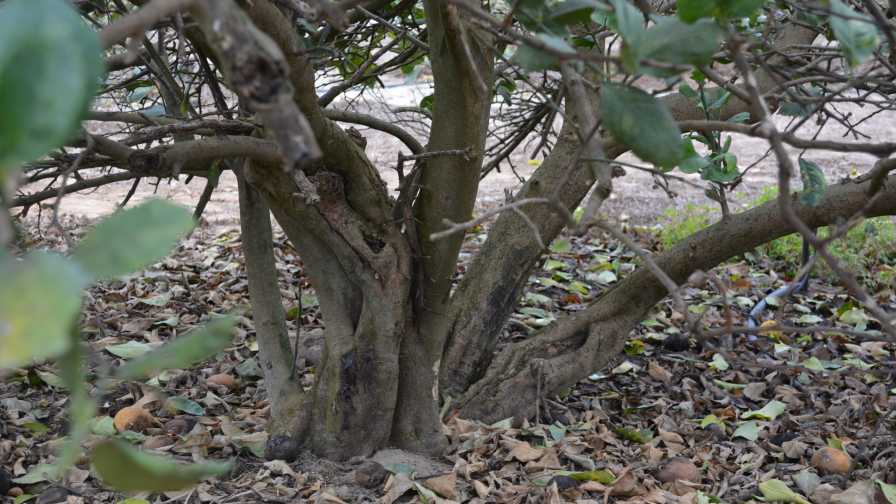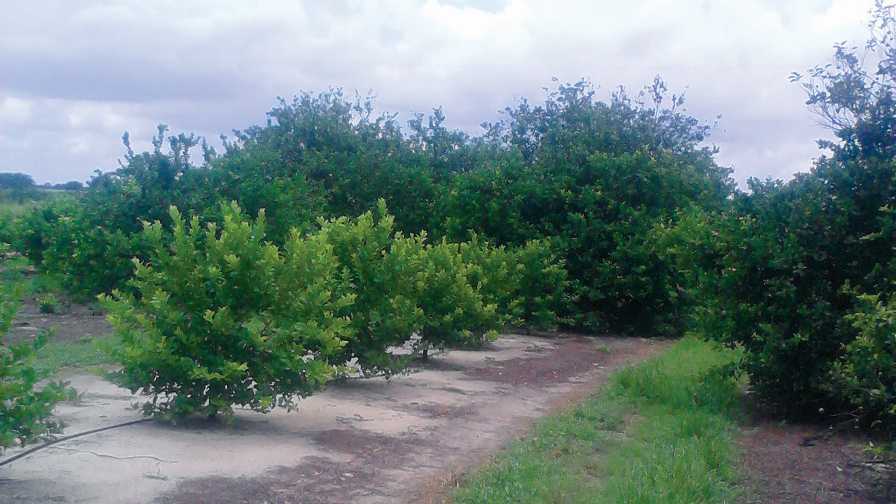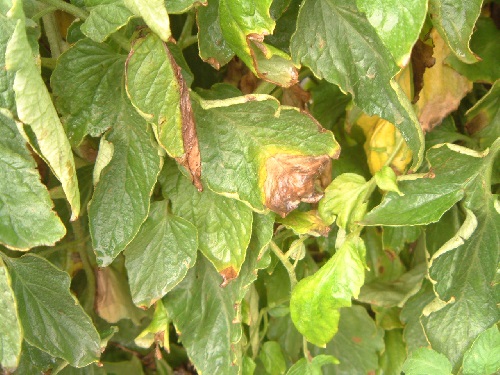Why Lemon Appeal Is Gaining Favor With Florida Growers

Mike Litvany stands by a 17-month-old lemon tree in his grove near Orlando, FL.
Photo by Frank Giles
With HLB endemic across the state, growers are trying a variety of production methods to squeeze more out of infected trees. In addition, they are planting new rootstocks and varieties in search of those that might show tolerance to the disease.
While lemons have never been a major crop in Florida, they are making a bit of a comeback because of a tolerance to HLB and a good market.
In the 1970s, Coke (Minute Maid) and Seminole Tribe of Florida produced an estimated 550,000 boxes of the fruit. But, the freezes of the 1980s largely took that production out.
After the freezes, growers mostly shied away from the crop, but HLB has changed that, and some are willing to give lemons a go. The tree’s vigorous growth pattern, which makes it more susceptible to cold, also has some benefits.
“They just seem to outgrow greening,” says Mike Litvany, who has managed a grove of lemons outside of Orlando since 1998. “You see the symptoms in the trees and all of mine are infected, but the root system is so vigorous, the trees just outgrow the disease.”
Fred Gmitter, a Professor of horticultural sciences with UF/IFAS, has observed this in lemon plantings as well. He says lemons are among the more tolerant citrus types that exist.
“They are easy to get infected and develop strong symptoms in the autumn and winter, but with good management, they outgrow the disease in the spring,” he says. “They will set a decent crop of fruit that can be harvested prior to the next autumn.”
Litvany got into the lemon business by happenstance. Nelson’s Nursery had lemon plants that were being thrown away, and a friend of his notified him they were about to be discarded.
“I like lemons and I had available land with irrigation in place, so I figured I might as well put them in the ground and see what happens,” he says. “These plants were on rooted cuttings, which is a little unusual, but it’s the only way to go this far north in the state.”

Lemon trees grow back quickly, replacing dead trunks with new ones.
Photo by Frank Giles
Since 1998, Litvany’s lemons have been burnt to the ground twice by freezes, but the lemons have come back because they are on their own roots.
“If they get busted by a freeze, it is OK. They will come back within a couple of years with a harvestable crop,” he adds.
Indian River Exchange Packers has been one of the the only packinghouses in the state working with lemons. It is a good way to get packing lines running early before grapefruit comes online.
Scott Lambeth, Production Manager for Golden River Fruit Company, has planted about 200 acres of lemons to feed the packinghouse. The first trees were planted in June 2015. He says they put them in for two reasons primarily.
“First, we know how to market them and pack them at Indian River Exchange Packers,” he says. “Second, we have noticed they are more tolerant to greening.”
The market is another good justification for the interest in lemons. The demand for juice and oil is strong. Florida’s climate is ideal for juice production and the summer price for lemon oil was about $24 per pound.
Litvany sells his lemons to Natalie’s Orchid Island Co. for juice. And, he says, oil sweetens the pot.
“Lemon oil is sort of the Holy Grail right now,” he says. “You can get about a half pound of oil per box; so if you can get about $18 per box for juice and $12 for oil, that’s $30 per box. You can make good money with that.”

One logistical challenge with lemons is working around big thorns during harvest.
Photo by Frank Giles
Management Considerations
According to Lambeth, growing lemons is similar in many ways to growing grapefruit. Regardless of citrus type, he says his production program is very aggressive whether it be psyllid control or plant nutrition to push trees toward early production.
“You name it, we are not holding anything back,” he says. “With lemons, you get fruit pretty quick and can pick after the first year. The old adage about picking and throwing the first crop on the ground doesn’t hold true with lemons. The first crop we hung, we picked, and packed.”
Lambeth says he has noticed lemons seem to be more susceptible to phytopthora, which requires aggressive ground treatments of Ridomil (mefenoxam, Syngenta) and Aliette (O-ethyl phosphate, Bayer) foliar applications when rains start.
He adds the trees don’t react well to salt water, which showed up in the drought of 2017 when Lambeth’s canals went dry forcing them to use well water for irrigation.
“The trees didn’t like the well water at all,” he says. “We backed off fertigation during that period not to compound the problem and used some seaweed extract and humic acid on the soils to help mitigate the salt problem. But, the biggest thing to fix that problem was 20 inches of rain.”
Litvany says his lemons mirror oranges in production practices. But, much of what he has learned has been trial and error since there is not much literature on growing from rooted cuttings.
“Size containment is going to be an issue because they grow so fast,” he says. “You are going to need to hedge and top. And, harvesting is going to be challenge because the trees are so thorny. I buy my pickers long leather welding gloves to protect against that.”
Litvany says the biggest challenge with rooted cuttings is the wind, which can beat up young trees’ root systems. There is no tap root and the root systems are bushy and more vertical. The grove experienced winds in excess of 100 mph when Hurricane Irma passed through.
“From day one on all future plantings, we will be putting a 1-inch wooden stake by the plants (not tied) to protect against wind,” he says. “We had tried other stakes, but they broke.”
Finally, he cautions rooted cuttings only would work on well-drained soils because foot rot can be a challenge.
Variety Central
Litvany has mostly ‘Bearss’ in his grove and he plans to plant about 1,000 more plants in the coming year.
“I really like the variety because it is so prolific, precocious, and it is pretty ‘booger’ resistant with a strong root system,” he says, “We just need to stake them because of the wind.”
Lambeth has planted ‘Eureka’ on Sour Orange.
“That is the horse we chose to ride since everything we put in the ground is for the fresh market,” he says.
Gmitter says UF/IFAS is getting most inquires about ‘Bearss’ because it has a good history of performance in Florida.
“‘Harvey’ is getting some attention because of low seed numbers and rumored greater cold tolerance,” Gmitter says. “But, the variety doesn’t produce much peel oil, so the byproduct production and value will be minimized.”
Gmitter says the UF/IFAS breeding team has been working on new lines for the past 15 years to develop lemons with substantially greater quantities of peel oil than current cultivars.
“In preliminary experiments and data collected across multiple seasons, we have some lines that averaged from 10% to 30% or more peel oil per fruit surface area,” he says. “These lemons will soon be available to Florida growers with an eye on the valuable byproduct market.”

Lemons are in high demand not only for juice, but also oil.
Photo by Peter Chaires
More to Come
According to Peter Chaires, Executive Director of the New Varieties Development and Management Corp., estimates show 200 to 225 acres of lemons are in production in the state. But, over the past three years, about 400,000 trees have been propagated, with nearly 124,000 of those registered for use as budwood increase.
“This would leave about 276,000 trees going into commercial production over the past three years, he says. “At a 140 trees per acre average, this would be another 1,970 acres of commercial production on the way. This raises the question why so many increase trees are needed. It is likely that this number is too high, resulting from nursery reporting errors. Nonetheless, even if this number is reduced significantly, it shows citrus nurseries are ramping up for some serious lemon propagation.”
Lambeth cautions growers considering lemons to be sure they have a market for their fruit and a packer or processor in place before planting them.
“This is a fragile market for lemons,” he says. “If everybody goes out and plants lemons, we can mess this market up. I don’t think we can handle a footprint of 10,000 acres in the state.”










